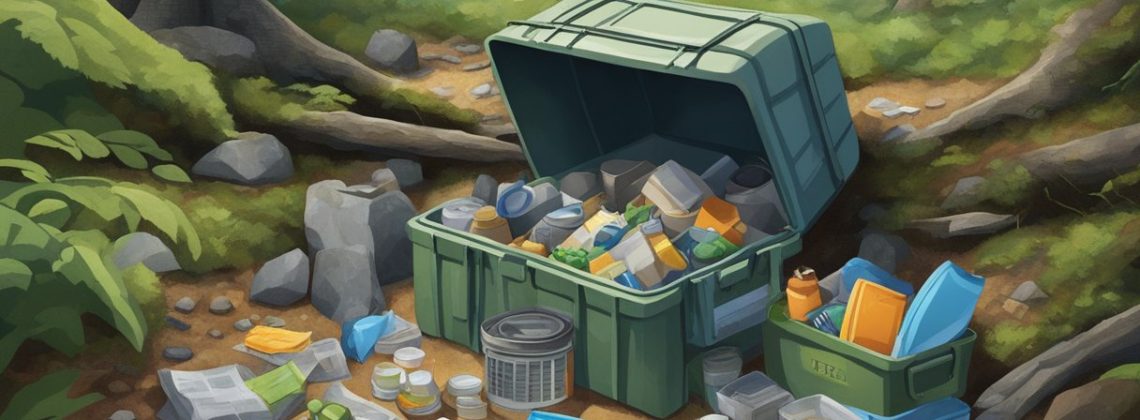
A survival cache is like a strategic investment in your safety and well-being in uncertain times. Imagine having a hidden supply filled with essentials like food, water, and tools that you could tap into when the going gets tough. It’s not merely about stocking up; it’s a planned dispersal of resources to ensure survival during emergencies or when you find yourself disconnected from your primary supplies.
While the idea of a survival cache seems foolproof, it’s a concept loaded with practical concerns. On the one hand, having supplies stashed away in various locations can provide peace of mind and a lifeline in dire circumstances. On the other hand, these stockpiles can be challenging to maintain and may even become compromised or difficult to reach when needed. Balancing the pros and cons while effectively planning your resources is the key to leveraging this strategy to its full potential.
Key Takeaways
- Stability during crises can hinge on effective resource management.
- Hidden stockpiles must be well-maintained and accessible.
- Resource dispersal is a nuanced strategy with substantial impacts on survival.
Understanding Survival Caches
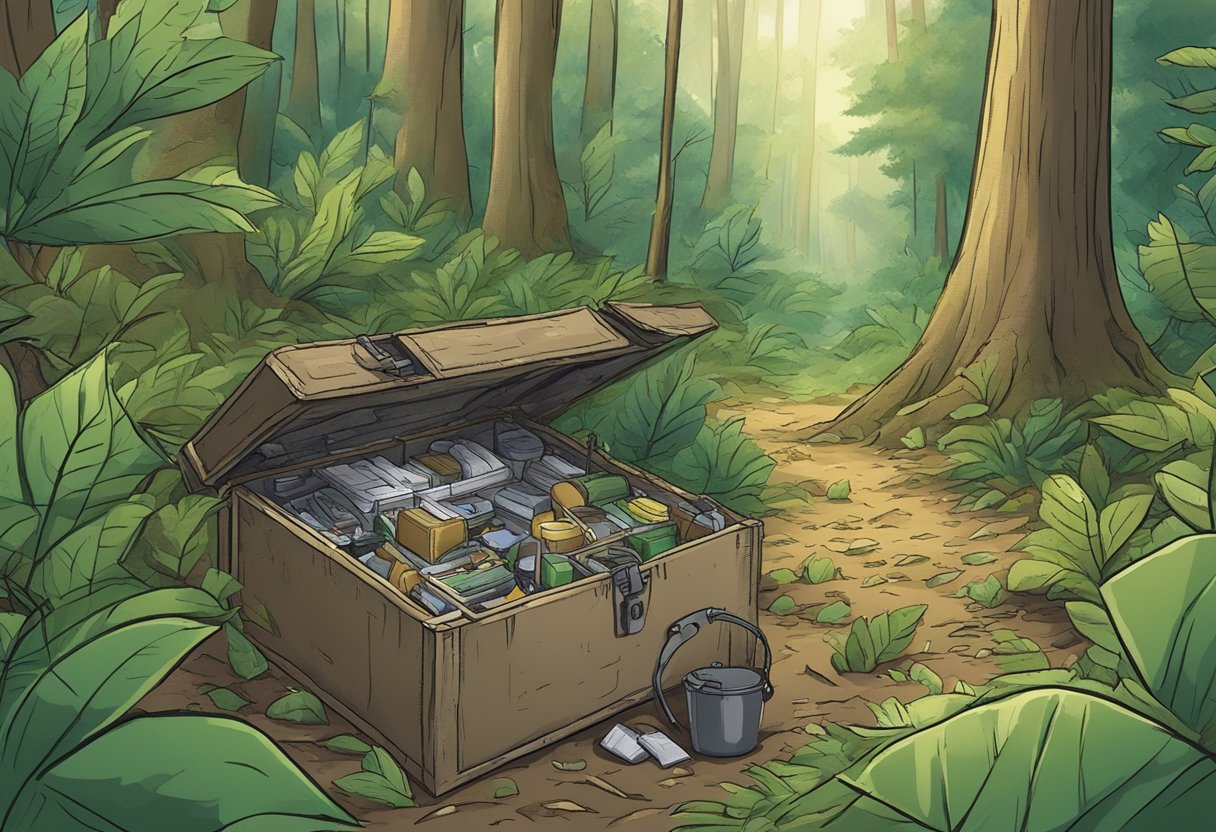
In the realm of preparedness, you may have come across the term ‘survival caches’. Here’s what you need to know about them and their intriguing role in history.
Definition and Purpose
Survival caches are your hidden stockpile of supplies, tucked away for future use in emergencies. Think of it as your safety net; a way to ensure that if something goes wrong, you’ve got a backup plan. Items in a cache can include non-perishable food, water, medical supplies, tools, or anything you’d need to survive without access to your primary resources.
- Key Components of a Survival Cache:
- Non-perishable food
- Clean water or water purification methods
- First-aid supplies
- Essential tools
- Defensive equipment
- Navigation aids
The purpose of a survival cache is multi-faceted. You’re not only looking to safeguard your supplies from theft, damage, or decay but also to ensure you have resources available at strategic points if you need to relocate quickly.
Historical Use
Historically, the concept of caches has been used for centuries, dating back to times of war and exploration. Soldiers would bury supplies for later retrieval, and explorers would stash food and gear on their routes to lighten their load and have reserves for their return journey.
- Examples of Historical Caches:
- Military supply caches
- Explorers’ depots
From the hidden assets of war to the secret stashes of arctic explorers, survival caches have served as a critical component for success in unforeseen conditions. Even in past pandemics, people have relied on scattered supplies as a measure against the uncertainty of supply chains.
Advantages of Survival Caches
Survival caches are like your safety nets, offering you benefits to ensure you’re ready for whatever comes your way.
Emergency Preparedness
You never know when disaster might strike, but having survival caches means you’ve got quick access to essential supplies. Think of them as your personal emergency kits strategically placed to ensure that whether you’re at home or on the run, you’re prepared. Your cache can hold everything from water and non-perishable food to first aid items and self-defense gear.
Resource Management
By creating separate caches, you’re essentially spreading out your resources which can help prevent total loss in case one location is compromised. It’s like not putting all your eggs in one basket. Not only do you avoid the risk of losing everything at once, but you also manage your supplies more efficiently, using resources from the nearest cache when needed.
Strategic Resupply Points
Imagine having multiple pit stops, each one with supplies that allow you to recharge and recalibrate on your journey. Survival caches act as these pit stops, situated in carefully chosen locations between your home and your bug out location (BOL). They are particularly handy if you’re forced to evacuate and need to sustain yourself en route to safety.
Disadvantages of Survival Caches
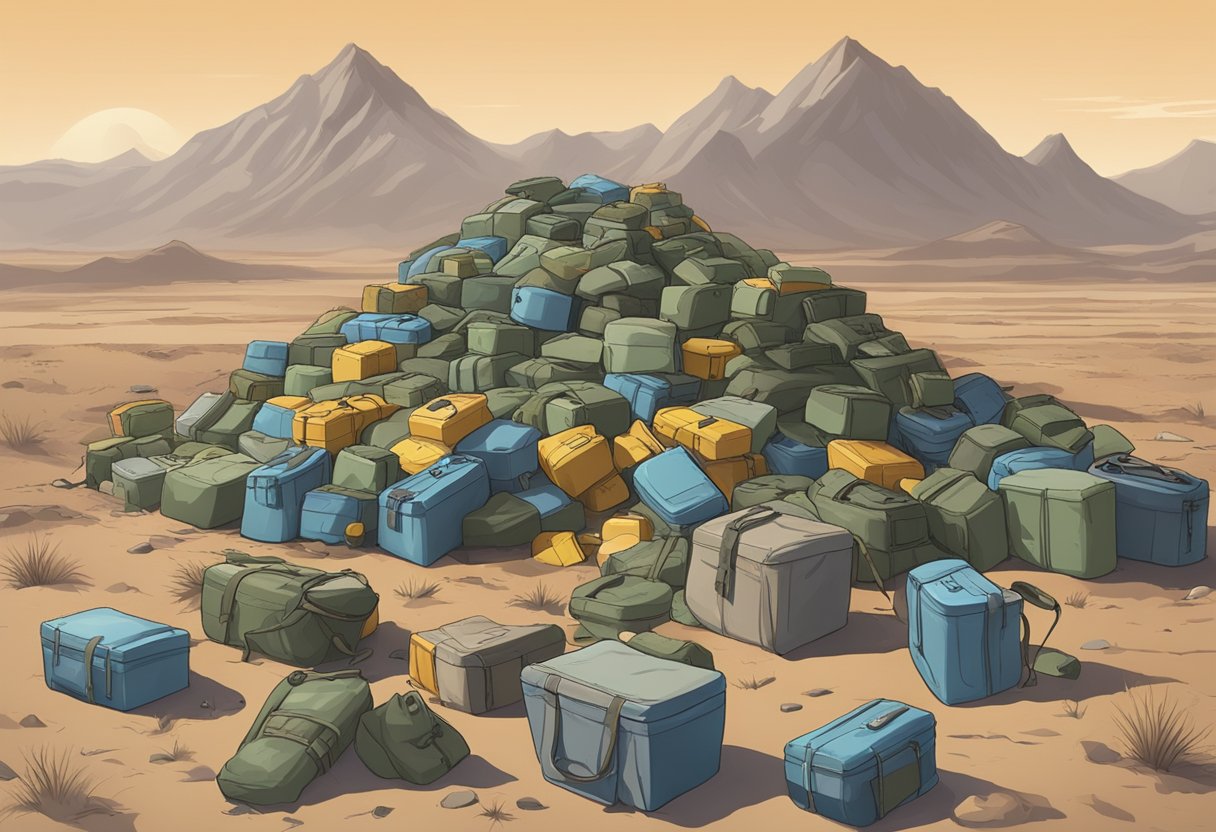
While stashing supplies can be a lifesaver in emergencies, it’s also not without its pitfalls. You need to be aware of these downsides as you plan your survival strategy.
Security Risks
Unauthorized Access: If your cache isn’t well-hidden or secured, you face the risk of it being discovered and looted by others. When your survival goods are not in your immediate possession, there’s always a chance that they could be tampered with or stolen outright.
Location Compromise: Should the location of your cache become known to others, it could attract unwanted attention, possibly leading to dangerous encounters.
Maintenance Challenges
Regular Checks and Updates: Your cache will require periodic checks to ensure everything is intact and not expired. These maintenance trips can be time-consuming and could potentially expose the cache’s location.
- Inventory Management:
- Check for damages and spoilage.
- Refresh supplies nearing expiration.
Weather and Animals: Your supplies might be compromised by weather conditions or animals. Moisture, mold, or rodents can ruin your survival stash if not appropriately safeguarded.
Legal and Ethical Considerations
Permissions and Laws: Not every place is fair game for stashing supplies. You need to ensure that you’re not violating any laws or trespassing on private property.
- Regulations to Consider:
- Land ownership
- Environmental protection laws
- Local ordinances
Moral Implications: In a disaster, the resources you’ve cached could be of use to others in dire need. Consider the ethical implications of keeping supplies to yourself, especially if your cache is on public land or within a community.
Resource Dispersal Strategies

When you’re planning for the unexpected, having a robust strategy for resource dispersal can make all the difference. It’s about balancing accessibility with security—ensuring you have what you need, where you need it, when you need it most.
Decentralized Storage
Decentralized Storage means stashing your critical supplies in different locations. Imagine having multiple mini-bases:
- Home Cache: Near enough for easy access.
- Remote Cache: Far enough to escape immediate danger zones.
Each cache might hold basic survival items like water filters, non-perishable foods, and first aid kits. This way, you’re never too far from your essentials.
Mobile Resource Units
With Mobile Resource Units, you’re taking a ‘carry-on’ approach:
- Backpack Kits: Tailored to sustain you for 72 hours.
- Vehicle Kits: Larger supplies that can turn your car into a survival station.
You can grab these on the fly, keeping vital resources at your side, even when you’re on the move.
Natural Resource Utilization
Tapping into Natural Resource Utilization involves knowledge and adaptability:
- Foraging Skills: Identifying edible plants and water sources.
- Hunting Know-how: Using the land’s fauna to your advantage.
This strategy relies on your skills and the local ecosystem to resupply, reducing the need for traditional caches.
Impact on Survival Outcomes
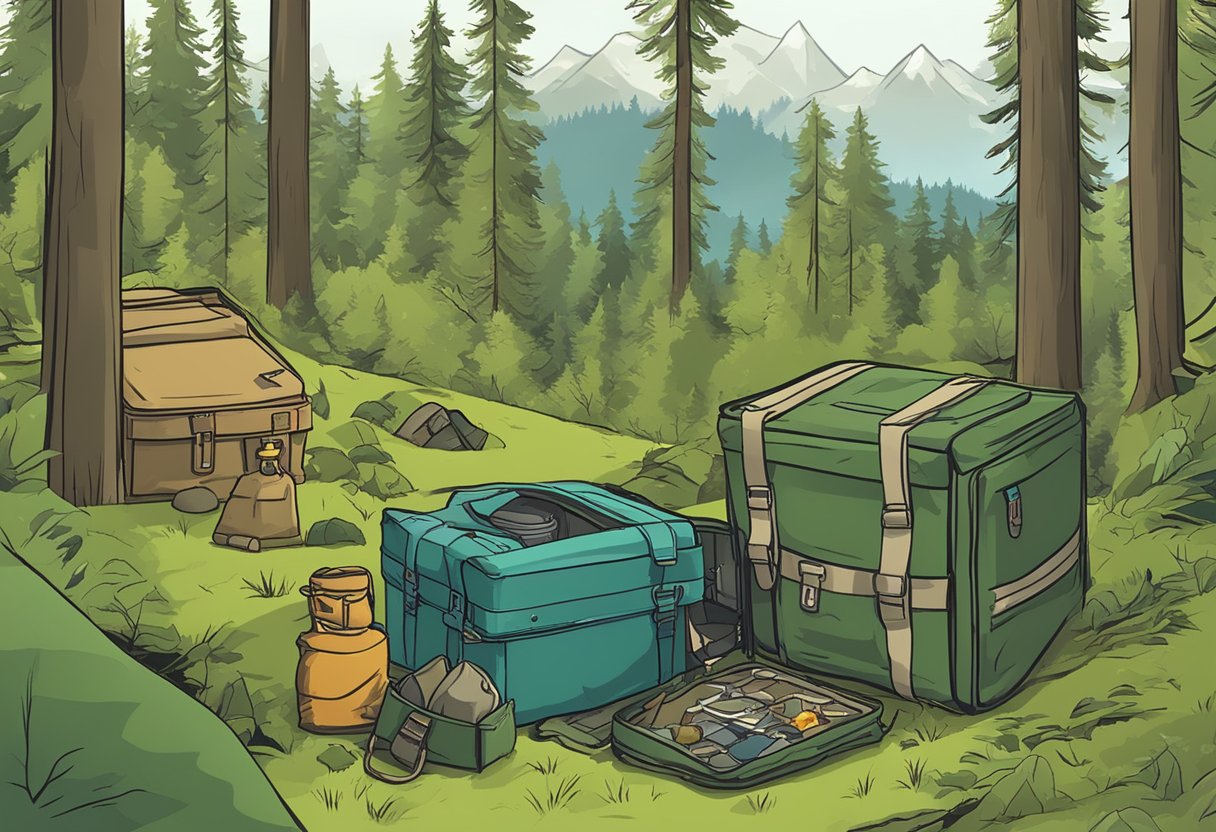
When you’re strategically placing survival caches or dispersing resources, you’re directly influencing your chances of making it through tough times. Here’s how it all plays out for you and your community.
Individual Survival Scenarios
What’s in your backyard could save your life. Imagine you’ve stashed emergency kits in various places around your property. Should a disaster strike and one part of your home become inaccessible, your odds of having essential supplies on hand just skyrocketed.
- Redundancy is key: You’ve got multiple kits, so if one is lost or destroyed, you’re not starting from scratch.
- Accessibility: Supplies located in various places mean you’re more likely to get to them in different emergency scenarios.
Community Resilience
It’s not just about you. Your whole neighborhood benefits when resources are spread out. After a major calamity, if you’ve got food, water, or medical supplies and others don’t, you strengthen not just your survival, but the community’s too.
- Shared caches: Encourage community buy-in and everyone’s better off.
- Organized dispersal systems: Can ensure faster recovery and aid distribution post-disaster.
Future of Resource Management

As you think about securing your future, it’s essential to know how advancements and global developments will shape the way you manage resources.
Technological Innovations
Innovation’s pace is relentless, and it’s transforming how you’ll handle resources. Imagine smart caches equipped with sensors and IoT (Internet of Things) connectivity. You’ll track and manage your resources in real time, with apps alerting you to low supplies or environmental changes that could impact your stash. With 3D printing technology, you might even fabricate parts or tools on demand, reducing the need to stockpile every conceivable item.
- IoT and sensors: Automated inventory and alerts
- 3D printing: On-demand resource production
Global Trends and Predictions
On a larger scale, global trends are pushing towards sustainable resource use and circular economies where waste is minimized, and products are reused and recycled. As predictions suggest a surge in efficiency, you must be ready to optimize your resource use.
- Sustainable resource use: Focus on renewable resources and reduced consumption.
- Circular economies: Systems where your resources are destined for reuse, extending their lifecycle and value.
Remember, as resource costs structure can shift, staying informed about these trends and tech puts you in control. Keep your strategy adaptable, because the resources you depend on today may not be the ones you’ll rely on tomorrow.
Conclusion
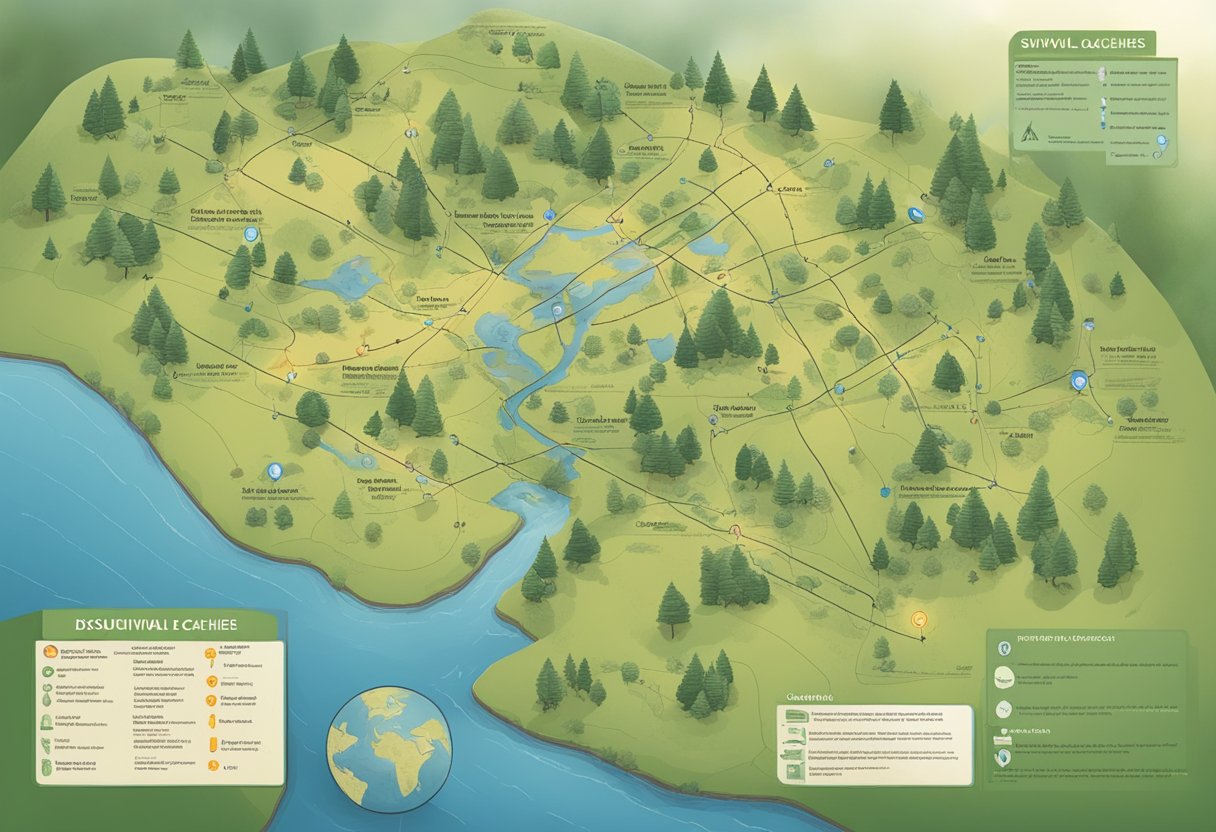
When you’ve got survival caches and resource dispersal on your prepping plan, it’s a game of balance. Your goal? Be prepared without going broke.
Pros of Survival Caches:
- With caches scattered, you don’t have all your eggs in one basket.
- Multiple locations mean you’re likely to have supplies no matter where you are.
- It’s like a safety net that you’ve spread out in several places.
Cons to Consider:
- It can get pricey—more gear, more money.
- Maintenance! You’ve got to keep all those caches in check.
- Security risks multiply with each new cache; they could be found or compromised.
If you’re investing in multiple caches, think of it as buying peace of mind. But remember, each additional cache asks for more from your wallet and your time to maintain. Make your prep count—diversify smartly and budget wisely.
Remember, the more caches you have, the better your chances in an emergency. But it’s crucial to balance quantity with quality, and not just stash your gear, but stash it well.
So, what’s your next move? Check your list, plan your budget, and decide how many caches hit that sweet spot for you. Because in the world of prepping, it’s not just about having a plan—it’s about having a plan you can actually pull off.

Leave a Reply